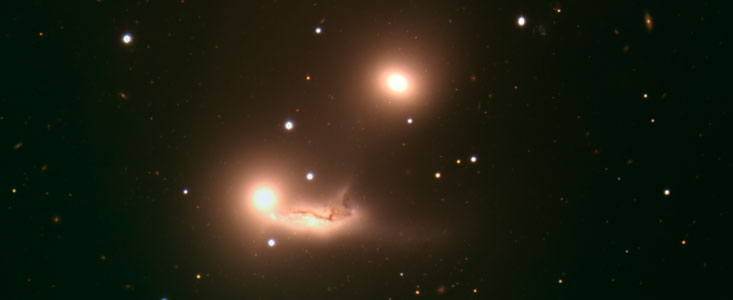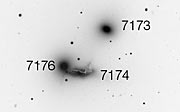Nota de prensa
Cosmic Interactions
VLT images triplet of dancing galaxies
21 de Enero de 2008
An image based on data taken with ESO's Very Large Telescope reveals a triplet of galaxies intertwined in a cosmic dance.
The three galaxies, catalogued as NGC 7173 (top), 7174 (bottom right) and 7176 (bottom left), are located 106 million light-years away towards the constellation of Piscis Austrinus (the 'Southern Fish').
NGC 7173 and 7176 are elliptical galaxies, while NGC 7174 is a spiral galaxy with quite disturbed dust lanes and a long, twisted tail. This seems to indicate that the two bottom galaxies - whose combined shape bears some resemblance to that of a sleeping baby - are currently interacting, with NGC 7176 providing fresh material to NGC 7174. Matter present in great quantity around the triplet's members also points to the fact that NGC 7176 and NGC 7173 have interacted in the past.
Astronomers have suggested that the three galaxies will finally merge into a giant 'island universe', tens to hundreds of times as massive as our own Milky Way.
The triplet is part of a so-called 'Compact Group', as compiled by Canadian astronomer Paul Hickson in the early 1980s. The group, which is the 90th entry in the catalogue and is therefore known as HCG 90, actually contains four major members. One of them - NGC 7192 - lies above the trio, outside of this image, and is another peculiar spiral galaxy.
Compact groups are small, relatively isolated, systems of typically four to ten galaxies in close proximity to one another. Another striking example is Robert's Quartet. Compact groups are excellent laboratories for the study of galaxy interactions and their effects, in particular the formation of stars.
As the striking image reveals, there are many other galaxies in the field. Some are distant ones, while others seem to be part of the family. Studies made with other telescopes have indeed revealed that the HCG 90 group contains 16 members, most of them much smaller in size than the four members with an entry in the NGC catalogue.
Notas
A list of all the work about this group of galaxies can be for example obtained through the Simbad astronomical database.
Elliptical galaxies are smooth and featureless entities, often composed of older, low mass stars, which produce very few new stars. Spiral galaxies consist of a flat, rotating disc of stars, gas and dust, and a central concentration of stars known as the bulge. The spiral arms are sites of ongoing star formation. Our own Milky Way is a spiral galaxy.
Acerca de la nota de prensa
| Nota de prensa No.: | eso0802 |
| Legacy ID: | PR 02/08 |
| Nombre: | NGC 7173, NGC 7174, NGC 7176 |
| Tipo: | Early Universe : Galaxy : Type : Interacting |
| Facility: | Very Large Telescope |
| Instruments: | FORS1 |
Our use of Cookies
We use cookies that are essential for accessing our websites and using our services. We also use cookies to analyse, measure and improve our websites’ performance, to enable content sharing via social media and to display media content hosted on third-party platforms.
ESO Cookies Policy
The European Organisation for Astronomical Research in the Southern Hemisphere (ESO) is the pre-eminent intergovernmental science and technology organisation in astronomy. It carries out an ambitious programme focused on the design, construction and operation of powerful ground-based observing facilities for astronomy.
This Cookies Policy is intended to provide clarity by outlining the cookies used on the ESO public websites, their functions, the options you have for controlling them, and the ways you can contact us for additional details.
What are cookies?
Cookies are small pieces of data stored on your device by websites you visit. They serve various purposes, such as remembering login credentials and preferences and enhance your browsing experience.
Categories of cookies we use
Essential cookies (always active): These cookies are strictly necessary for the proper functioning of our website. Without these cookies, the website cannot operate correctly, and certain services, such as logging in or accessing secure areas, may not be available; because they are essential for the website’s operation, they cannot be disabled.
Functional Cookies: These cookies enhance your browsing experience by enabling additional features and personalization, such as remembering your preferences and settings. While not strictly necessary for the website to function, they improve usability and convenience; these cookies are only placed if you provide your consent.
Analytics cookies: These cookies collect information about how visitors interact with our website, such as which pages are visited most often and how users navigate the site. This data helps us improve website performance, optimize content, and enhance the user experience; these cookies are only placed if you provide your consent. We use the following analytics cookies.
Matomo Cookies:
This website uses Matomo (formerly Piwik), an open source software which enables the statistical analysis of website visits. Matomo uses cookies (text files) which are saved on your computer and which allow us to analyze how you use our website. The website user information generated by the cookies will only be saved on the servers of our IT Department. We use this information to analyze www.eso.org visits and to prepare reports on website activities. These data will not be disclosed to third parties.
On behalf of ESO, Matomo will use this information for the purpose of evaluating your use of the website, compiling reports on website activity and providing other services relating to website activity and internet usage.
Matomo cookies settings:
Additional Third-party cookies on ESO websites: some of our pages display content from external providers, e.g. YouTube.
Such third-party services are outside of ESO control and may, at any time, change their terms of service, use of cookies, etc.
YouTube: Some videos on the ESO website are embedded from ESO’s official YouTube channel. We have enabled YouTube’s privacy-enhanced mode, meaning that no cookies are set unless the user actively clicks on the video to play it. Additionally, in this mode, YouTube does not store any personally identifiable cookie data for embedded video playbacks. For more details, please refer to YouTube’s embedding videos information page.
Cookies can also be classified based on the following elements.
Regarding the domain, there are:
- First-party cookies, set by the website you are currently visiting. They are stored by the same domain that you are browsing and are used to enhance your experience on that site;
- Third-party cookies, set by a domain other than the one you are currently visiting.
As for their duration, cookies can be:
- Browser-session cookies, which are deleted when the user closes the browser;
- Stored cookies, which stay on the user's device for a predetermined period of time.
How to manage cookies
Cookie settings: You can modify your cookie choices for the ESO webpages at any time by clicking on the link Cookie settings at the bottom of any page.
In your browser: If you wish to delete cookies or instruct your browser to delete or block cookies by default, please visit the help pages of your browser:
Please be aware that if you delete or decline cookies, certain functionalities of our website may be not be available and your browsing experience may be affected.
You can set most browsers to prevent any cookies being placed on your device, but you may then have to manually adjust some preferences every time you visit a site/page. And some services and functionalities may not work properly at all (e.g. profile logging-in, shop check out).
Updates to the ESO Cookies Policy
The ESO Cookies Policy may be subject to future updates, which will be made available on this page.
Additional information
For any queries related to cookies, please contact: pdprATesoDOTorg.
As ESO public webpages are managed by our Department of Communication, your questions will be dealt with the support of the said Department.


